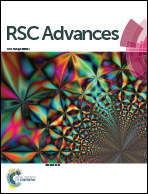Structural modification of olibergin A, an isoflavonoid, from Dalbergia stipulacea Roxb. and its cytotoxicity†
Abstract
Fifteen derivatives were synthesized from olibergin A, a major isoflavonoid isolated from the stems of Dalbergia stipulacea Roxb. All compounds were evaluated for cytotoxicity against HCT-116, HT-29, MCF-7 and vero cell lines using MTT assay. Cytotoxicity results showed 5-hydroxy-7,2′,4′,5′-tetramethoxyisoflavone (5) was the most active with IC50 values of 19.03 ± 0.70, 10.83 ± 1.65, 12.53 ± 0.70 and 13.53 ± 0.84 μM against HCT-116, HT-29, MCF-7 and vero cell lines, respectively. It should be noted that 5-hydroxy-7,2′,4′,5′-tetramethoxyisoflavone (5) showed two times less toxicity against vero cells than the cisplatin standard (IC50 = 6.55 ± 0.81 μM) while 5 and cisplatin exhibited nearly equal cytotoxicity against the MCF-7 cell line. 5,7,2′,4′,5′-Pentamethoxyisoflavanone (10) showed an IC50 value of 30.34 ± 1.15 μM against the HCT-116 cell line and exhibited weak cytotoxicity against normal cells, the vero cell line. In addition, 5,7,4′-trihydroxy-2′,5′-dimethoxyisoflavan oxime (13) demonstrated cytotoxicity against HT-29 cells with an IC50 value of 31.41 ± 1.38 μM and displayed weak activity toward the vero cell line. The information revealed that these compounds were suitable for development to anticancer agents against HCT-116, HT-29 and MCF-7 cell lines.



 Please wait while we load your content...
Please wait while we load your content...